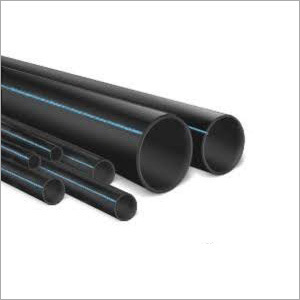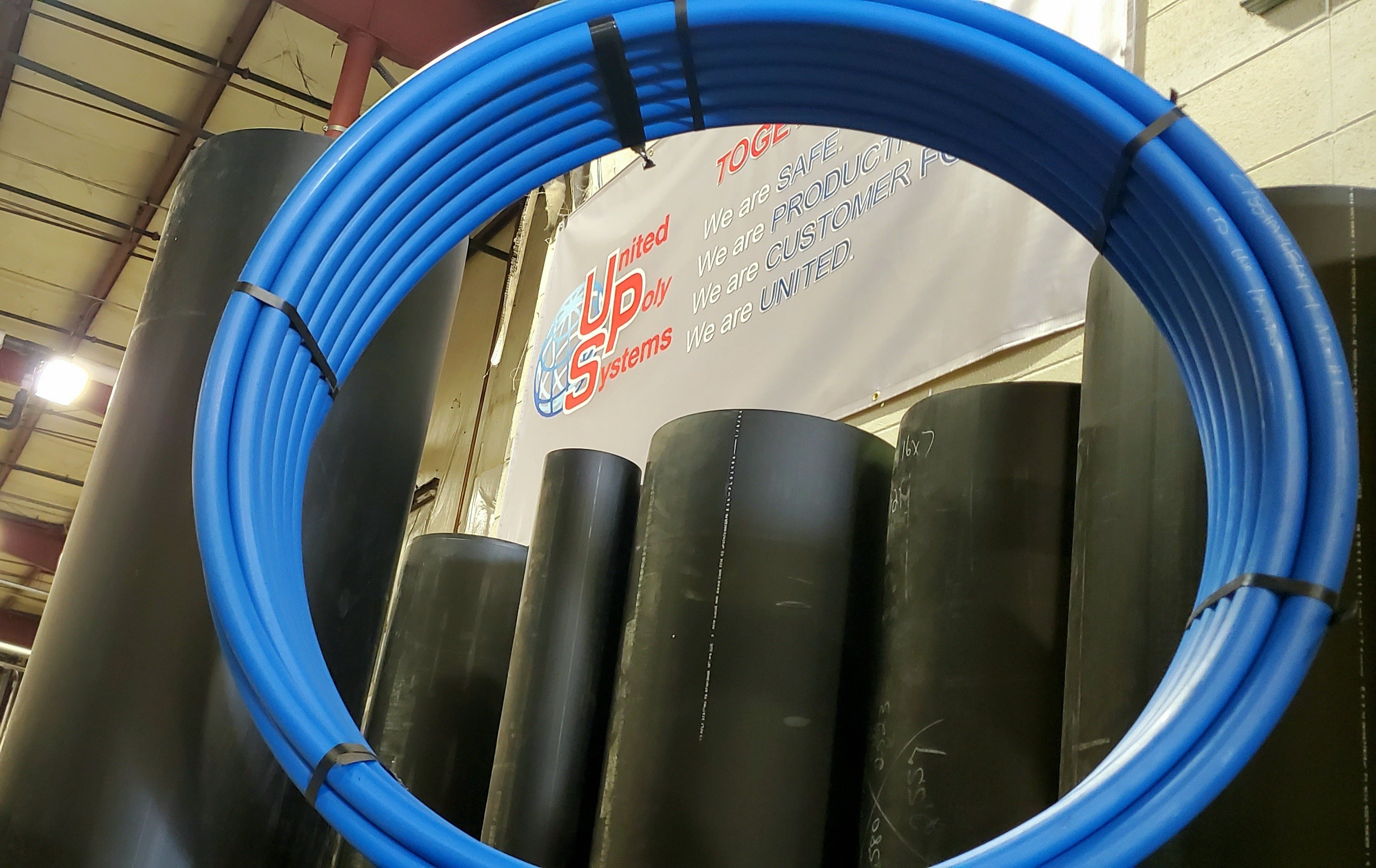How to Install hdpe pipe fittings Midland TX for System Longevity
Wiki Article
Discover the Manufacturing Refine Behind High-Quality HDPE Pipeline and Its Applications
The manufacturing process of high-grade HDPE pipes is elaborate and methodical. It begins with the option of raw products that improve performance. Following this, ethylene undertakes polymerization to develop resin, which is then formed through extrusion. Quality control is extremely important, guaranteeing that the end product satisfies stringent requirements. However, the trip of HDPE pipelines doesn't end with manufacturing. Their applications throughout different markets reveal a more comprehensive value worth taking a look at.Recognizing HDPE: Qualities and Advantages

High-density polyethylene (HDPE) is a versatile thermoplastic known for its sturdiness and resistance to numerous environmental elements. This product exhibits outstanding tensile toughness, making it suitable for demanding applications. Its low-density structure adds to a light-weight item, helping with convenience of handling and installation. HDPE also showcases exceptional resistance to chemicals, which lessens deterioration when subjected to harsh compounds.
The material's low moisture absorption even more enhances its durability, making it suitable for use in pipes and tank. In addition, HDPE is resistant to ultraviolet (UV) radiation, making sure that items keep their stability also when subjected to sunshine. Additionally, its adaptability allows for the creation of detailed forms without jeopardizing toughness. The green nature of HDPE, frequently stemmed from recycled products, includes to its allure, promoting sustainable techniques in manufacturing. In general, these residential properties and benefits make HDPE a preferred selection for numerous industrial and customer applications.
Resources Selection for HDPE Production
The choice of resources for HDPE manufacturing is important to confirm the end product meets the preferred specifications and top quality standards. High-density polyethylene (HDPE) is mainly created from polymerized ethylene, stemmed from fossil fuels such as all-natural gas or crude oil. The quality of these feedstocks substantially affects the mechanical and thermal residential or commercial properties of the final HDPE.Ingredients additionally play a considerable role in enhancing HDPE's performance, consisting of antioxidants, UV stabilizers, and colorants, which enhance longevity and resistance to environmental factors. The selection process have to take into consideration not only the chemical structure of the raw materials however additionally their handling attributes to guarantee reliable manufacturing.
Moreover, the sourcing of raw products ought to focus on sustainability and compliance with environmental guidelines, as liable techniques are necessary in today's market. Inevitably, cautious raw product choice lays the foundation for creating high-grade HDPE pipelines appropriate for varied applications.
The Extrusion Process: Shaping HDPE Pipeline
The extrusion process plays an important function in shaping HDPE pipes, starting with meticulous material preparation methods that guarantee perfect circulation and uniformity. Similarly important is the style of the die, which directly influences the final dimensions and surface area high quality of the pipe. Together, these variables add greatly to the performance and quality of HDPE pipe production.Material Preparation Techniques
Efficient manufacturing of HDPE pipes starts with meticulous product prep work methods, specifically the extrusion process. During this stage, high-density polyethylene material is very first dried to eliminate moisture, making sure perfect flow qualities. The material is after that fed into the extruder, where it undertakes heating and melting, transforming into a viscous state. This heating procedure is thoroughly managed to preserve the product's honesty and performance. The liquified HDPE is forced via a die, shaping it right into a constant pipeline kind. Correct temperature management throughout extrusion is vital, as it straight impacts the material's properties and the last item high quality. When formed, the HDPE pipe is cooled and reduced to defined lengths, all set for subsequent processing and applications.Die Layout Significance
Accuracy in die style plays a vital role in the extrusion process of HDPE pipelines. The die functions as the final shaping device, straight influencing the pipe's dimensions, wall surface thickness, and surface area finish. A well-designed die guarantees uniform material flow, reducing flaws such as abnormalities and vulnerable points. The geometry of the die have to be enhanced to fit the details buildings of HDPE, including its viscosity and thermal behavior throughout extrusion. Furthermore, the cooling rate recommended you read of the product as it passes via the die can substantially influence the pipeline's architectural integrity. As a result, spending in advanced die modern technology is crucial for producers aiming to create top quality HDPE pipelines that fulfill sector requirements and client expectations.Quality Assurance Measures in HDPE Manufacturing
Various elements affect the top quality of HDPE pipeline manufacturing, effective quality control actions are crucial to guarantee consistency and dependability in the last product (custom hdpe pipe manufacturing Midland TX). Trick quality assurance techniques consist of extensive material examination, validating that the raw polyethylene meets well established criteria for purity and density. Throughout the extrusion procedure, specifications such as temperature level, pressure, and cooling time are carefully kept an eye on to keep dimensional precision and architectural honestyread this post here Furthermore, post-production screening is essential; producers typically carry out hydrostatic tests to assess the pipe's toughness and resistance to pressure. Aesthetic assessments for surface area problems additionally enhance quality control. Accreditation from appropriate standards organizations, like ASTM or ISO, provides an additional layer of trustworthiness. By applying these thorough quality assurance procedures, manufacturers can reduce flaws, improve performance, and make sure that the HDPE pipelines meet the particular needs of numerous applications, inevitably leading to client satisfaction and rely on the item.
Applications of HDPE Pipe Across Industries
HDPE pipelines are made use of throughout numerous markets because of their toughness and versatility. In water distribution systems, they guarantee reliable shipment, while in wastewater administration, they offer dependable options for waste transportation. In addition, farming watering networks take advantage of HDPE's resistance to deterioration and versatility, making it a perfect option for modern farming techniques.
Water Circulation Solutions
A considerable variety of industries depend on high-density polyethylene (HDPE) pipelines for effective water distribution systems. Recognized for their resilience and resistance to rust, HDPE pipes are extensively utilized in municipal water system networks, farming watering, and industrial applications. Their light-weight nature facilitates simple handling and setup, lowering labor expenses and time. Furthermore, HDPE pipelines can fit numerous stress levels, making them suitable for both low and high-pressure systems. hdpe pipe in stock Midland TX. The versatility of the product permits seamless combination right into existing facilities, reducing the requirement for extensive excavation. Moreover, HDPE's resistance to chemical seeping guarantees that the water delivered remains safe and tidy, making it a perfect choice for preserving the top read the full info here quality of drinkable water throughout various industriesWastewater Management Solutions
Efficient water distribution systems also pave the method for innovative wastewater monitoring options, where high-density polyethylene (HDPE) pipes play a significant role. Renowned for their resilience and resistance to corrosion, HDPE pipelines are suitable for delivering wastewater in numerous setups. Their versatility enables easy setup in complex environments, reducing the need for substantial excavation. Additionally, HDPE's smooth interior surface area reduces rubbing, enhancing flow prices and performance. These pipelines are additionally immune to chemical leaching, making certain that pollutants do not endanger the surrounding environment. Industries, municipalities, and treatment facilities significantly count on HDPE pipelines for their reliability and longevity, making them a preferred selection for modern-day wastewater administration systems. This flexibility highlights the vital value of HDPE pipelines across various applications.Agricultural Irrigation Networks
Agricultural watering networks profit significantly from using high-density polyethylene (HDPE) pipelines, which give reliable and reliable water shipment to crops. HDPE pipes are lightweight, making them very easy to deliver and set up, while their versatility enables different setups in varied terrains. These pipelines show excellent resistance to deterioration, chemicals, and UV radiation, making sure durability in rough agricultural atmospheres. Furthermore, their smooth indoor surface reduces rubbing loss, enhancing water circulation and minimizing energy costs linked with pumping. The longevity of HDPE pipelines, usually going beyond half a century, adds to decrease upkeep and substitute costs. Consequently, farmers progressively count on HDPE pipelines to boost irrigation effectiveness and promote sustainable agricultural techniques, eventually leading to improved plant yields and resource conservation.Future Patterns in HDPE Pipeline Technology
As the demand for sustainable and efficient framework expands, improvements in HDPE pipeline technology are poised to transform different markets. Emerging fads include the assimilation of smart modern technologies, such as sensors and IoT capabilities, which promote real-time tracking of pipeline conditions, lowering upkeep expenses and avoiding leaks. Additionally, the growth of sophisticated manufacturing strategies, such as 3D printing, is enabling the production of complex, tailored pipeline layouts that cater to specific task requirements.The focus on recycling and round economic climate techniques is driving the technology of HDPE pipelines made from recycled materials, improving sustainability. Improved jointing methods, such as electro-fusion and mechanical installations, are likewise enhancing setup performance and dependability. The growing focus on ecological laws is pushing suppliers to take on greener production processes, ensuring that HDPE pipes not just satisfy industry standards however additionally promote an even more lasting future for framework advancement.
Frequently Asked Concerns
Just How Does HDPE Contrast to Various Other Plastic Materials?
HDPE outperforms lots of various other plastic products relating to durability, chemical resistance, and flexibility. Its reduced density and high tensile stamina make it excellent for different applications, usually exceeding alternatives in both efficiency and longevity.What Are the Ecological Effects of HDPE Production?
The ecological influences of HDPE manufacturing include greenhouse gas exhausts, energy consumption, and possible contamination from producing procedures. Additionally, incorrect disposal can bring about soil and water contamination, raising issues about long-lasting ecological effects.Can HDPE Pipes Be Reused?
Yes, HDPE pipes can be reused. Lots of centers accept made use of HDPE for processing, transforming it right into brand-new products. This recycling adds to sustainability efforts, reducing plastic waste while conserving sources and power in the production cycle.What Is the Life-span of HDPE Piping?

How Do Temperature Variations Affect HDPE Pipeline Efficiency?
Temperature level variants significantly influence HDPE pipe performance, influencing versatility and strength. Heats can cause softening, while low temperature levels might create brittleness, eventually influencing the pipe's toughness and viability for various applications in diverse environments.Report this wiki page